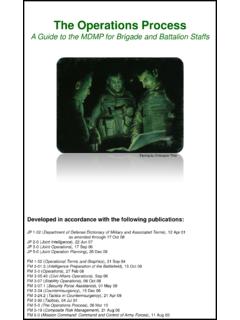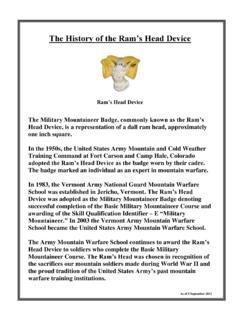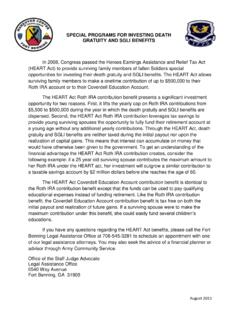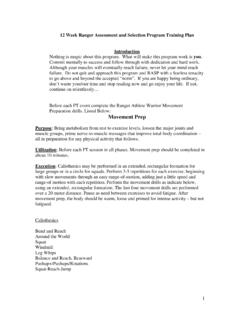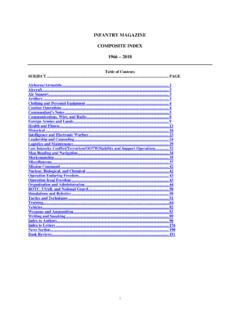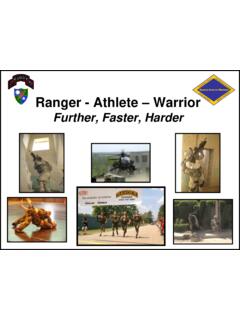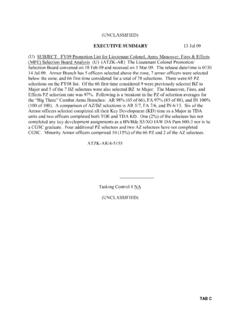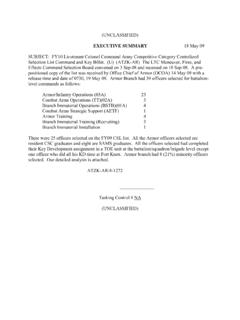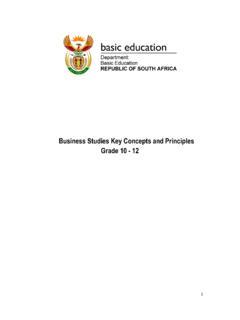Transcription of The Role and Responsibility of the ... - United States Army
1 October-December 2013 29 Four armored brigade combat teams (ABCTs) conducted decisive-action (DA) rotations at the National Training Center (NTC) in the past year. A trend observed during these rotations was that command sergeants major typically did not attend brigade sustainment rehearsals. However, when one unit did send its CSMs to brigade sustainment rehearsals, it struggled considerably less in synchronizing logistical support throughout the rotation. The unit s leadership appreciated the importance of the sustainment warfighting function and used these opportunities to assist in accomplishing the brigade commander s , sustainment does not drive the tactical-planning process, but if not fully integrated, it can impede operational reach, freedom of action and the BCT s prolonged endurance. This article discusses the impact of the CSM s absence from the brigade sustainment absentThe brigade s dissemination of the concept of support does not nullify the need for a sustainment rehearsal as implied in army Doctrine Publication 5-0, The Operations Process.
2 This rehearsal provides confirmation of and enhances unit leaders understanding of the concept of support. In spite of this, senior-enlisted observers/coaches/trainers (O/C/Ts) have routinely observed limited senior-noncommissioned-officer (NCO) attendance at rehearsals. Consistently the only exception was the brigade-support-battalion CSM. So the question is why do CSMs not prioritize the brigade sustainment rehearsal as a must-attend?The reasons are varied. Some CSMs have insisted that time constraints and competing requirements prevented participation. Others failed to realize its relevance as compared to the combined-arms rehearsal or fires rehearsal. Units admit a heavy reliance on the brigade tactical standard operating procedure, coupled with staff backbriefs, as The Role and Responsibility of the Command Sergeant Major within the Armor Brigade Combat Team in the Sustainment Warfighting Functionby CSM Jason A.
3 Runnelsa replacement for sustainment rehearsals. Leaders of many of these battalions routinely train independently at home station, with one battalion at a time in the field due to several constraints. Even units that get multiple battalions into the field at once often fail to replicate the same distance, dispersion and complexities as seen at NTC. Some units remain semi-reliant on installation support facilities. Usually, the support units co-locate, making the distance so small that resupply is easy. This training leads to a misconception that units have figured out their plan to support the , sustainment synchronization and rehearsals do not receive full training at brigade level, and leaders do not clearly know their Soldiers and equipment s capabilities. Within this scenario, sergeants major will not fully see their need and role in of absenceThe impact of senior NCOs involvement in the sustainment-planning process means that significant input by those with extensive military experience often goes unaddressed.
4 An in-depth analysis would reveal that most units would discover few, if any, E-9s par-ticipate in the wargaming, analysis and concept-of-support production or planning. The methodology excluding CSM participa-tion in the rehearsal process creates unnec-essary logistical challenges. At minimum, the operations sergeant major should at-tend in the CSM s uncoiling from the tactical assembly area in preparation for the defense or movement to the line of departure, well-intentioned, uninformed leaders often mismanage brigade logistical capabilities because of this. A second order of effect can lead to hasty requests for echelons-above-brigade sustainment functions of logistics, personnel services and health services are 30 October-December 2013nothing new to career NCOs. They routine-ly engage in these areas throughout their career and receive education on them dur-ing their professional military education.
5 Therefore, it is clear these leaders actions are not ill-intentioned but suffer from limit-ed experience in how best to effectively as-sist their commander in mission command while conducting combined-arms maneuver and wide-area security. As the operational tempo increases, commanders become ful-ly engaged conducting operations, and CSMs habitually discover they are trying to assist the battalion s logistical operations without extensive knowledge or under-standing of the sustainment the combined-arms battalion Field Manual (FM) does not directly address the battalion CSM s role concerning logistical responsibilities, it does indicate their need to position themselves at the point on the battlefield most likely to encounter friction, allowing them to assist their commander. Given the DA rotations to date, sustainment synchronization and execution has been the biggest friction. This point of difficulty is worthy of expounding on and can be quite different when comparing a DA to a counterinsurgency (COIN) environment.
6 Transitioning swiftly between DA offensive and defensive operations against a complex threat and the complexity of logistics to sustain this momentum are much different than our forces are familiar with in a COIN fight. It is therefore reasonable to presume that during the army s last 12 years of fighting in Iraq and Afghanistan, a training or knowledge gap may have occurred. Before 2001, many CSMs were serving at the first sergeant and platoon sergeant level, while their commanders were serving in major and captain positions. Therefore, this may account for a lack of emphasis on attendance at the sustainment generally emulate their leader s example. If the brigade CSM does not en-force attendance of the battalion CSMs at the brigade sustainment rehearsal, it is consequently no surprise that first sergeants are also routinely absent from the battalion sustainment rehearsal. FM , Tank and Mechanized Infantry Company Team, specifies the first sergeant helps the commander to plan, coordinate and supervise all logistical activities that sup-port the tactical mission.
7 If battalion CSMs in the BCT lack the firsthand knowledge solidified at the brigade s sustainment re-hearsal, their ability to advise, mentor and train their first sergeants about logistics is impeded. This results in first sergeants per-forming in the same manner as their CSM s NCOs at platoon, company and battalion level often serve as the linchpins at logistic-resupply points (LRPs), casualty collection points, maintenance collection points and ambulance exchange points (AXPs) during operations. It is therefore imperative that CSMs have an in-depth knowledge of the brigade s logistical plan and the impact of leading Soldiers with little or no knowledge of sustainment operations. Finally, the ability to assist the battalion executive officer and appropriately advise the commander in areas of logistics is a key part of the CSM s leadership position. Therefore, the presence of CSMs at the brigade sustainment rehearsal cannot be plethora of information may be exposed or re-emphasized at the brigade sustainment rehearsal if executed appropriately, as outlined following.
8 This is not an all-inclusive list, but it includes the major areas of concern consistently observed by all functional CSM O/C/Ts at NTC. Sustainment graphics (maneuver am-munition seal/frequency assignment sub-committee/AXP/forward-logistics ele-ment (FLE)/brigade-support battalion). Consumption rates based on mission, tempo and environmental considerations. Primary Alternate Contingency Emer-gency communication plan, Battle Com-mand Support and Sustainment system /Command Post of the Future/Very Small Aperture Terminals/frequency modula-tion (FM)/Force XXI Battle Command Bri-gade and Below/Blue Force Tracking. Commander s logistical critical-informa-tion requirements. Administration and logistics FM com-munications retransmission 2013 31 Logistical status reporting time and meth-od (bottom-up refinement). Casualty and equipment estimates. Phase-line triggers for AXPs: manned or unmanned. Medical evacuation/casualty evacuation air/ground/non-standard, security and flow of requests and reporting.
9 Limited illume and night logistical-plan-ning considerations. Class VIII distribution plan (Directorate of Environmental Compliance and Man-agement). Displacement of ambulances by type/location/triggers. Responsibilities for evacuation from Role I to Role II treatment facilities and se-curity requirements. Casualty and personnel replacement. Dirty routes/decontamination logistical requirements/decontamination loca-tions. Human-remains recovery plan/clear team responsibilities/Mortuary Affairs loca-tion. Class I rations cycle. Class III distribution/tactical-retail op-erations. Class V authorization, distribution and re-distro guidance; consumption reporting. Equipment evacuation/retrograde and catastrophic recovery. 5988E flow and Class IX management. Clarity of the definitions associated with green/red/amber reporting and days of supply. FLE composition and priority of support. Trash and waste management. Emergency resupply ground/air capa-bilities.
10 Personnel, equipment and capability of the field transportation/combat trans/company trans or combined-arms-bat-talion support area. LRPs (tailgate/service station/reduction and suicide prevention). Consequence-management packages: content/location. Pre-staged logistical packages: contents/location. Forward army and refueling points loca-tion/capacity. Religious these are necessary for the brigade s logistics common operating picture to remain relevant and to allow the brigade commander to make informed of the impact associated with not covering intricate details in the brigade sustainment rehearsal we commonly see here at NTC are: Poor backwards planning; High number of died of wounds ; Loss of combat power; Over- and under-resupply of Class III; Missed link-ups at LRPs; Inaccurate logistics-status reports; Class V shortfall by type; Unknown disposition of friendly forces; Fratricide; Slow personnel replacement; and Loss of communication with support units rely on emergency resupply as the answer to their lack of coordination, synchronization and understanding of the concept of support.
